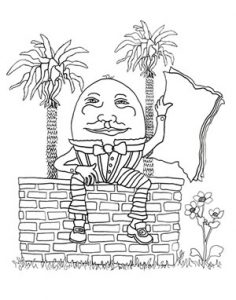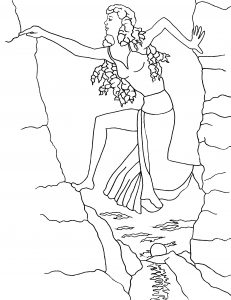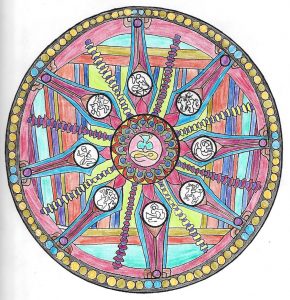Written by Terry Marks-Tarlow
Reviewed by Nancy Eichhorn
The truth?
I can be mindful and present when I’m walking. Some of my most inner most soul connected times are when I’m hiking. Movement takes on its own rhythm. My mind stops as my footsteps continue. I lose track of the fact that I’m not keeping track of what’s what in my brain. The mental chatter fades and a deep tranquility fills my being, awe overcomes me, joy embraces me.
 But, I struggle to sit still (unless I’m sitting outside in nature, but I’m talking about everyday life here). Ask me to sit and be silent? Well my mental chatter loves to make me nuts. I focus on the breath. I focus on sensation. I focus on the fact that I am not focusing, with a touch of loving kindness and compassion. I am kind to myself no doubt there; I accept that my mind loves to whirl and twirl, to take facts and create stories, to take a fleeting image or sensation and create a long-winded tale. Even here, on the page, the words keep flowing when the point has most likely already been made.
But, I struggle to sit still (unless I’m sitting outside in nature, but I’m talking about everyday life here). Ask me to sit and be silent? Well my mental chatter loves to make me nuts. I focus on the breath. I focus on sensation. I focus on the fact that I am not focusing, with a touch of loving kindness and compassion. I am kind to myself no doubt there; I accept that my mind loves to whirl and twirl, to take facts and create stories, to take a fleeting image or sensation and create a long-winded tale. Even here, on the page, the words keep flowing when the point has most likely already been made.
I’ve read countless books (reviewed many, done the practices). I’ve attended webinars and workshops and meditation groups, all with the same frustration. Silence while sitting escapes me. I thought I was hopeless until now.
Terry Marks-Tarlow saved me, well, maybe not quite that dramatic, but her new book, Truly Mindful Coloring, is in fact a great tool for me to calm down, reduce my stress and appreciate self-expression, mine that is, not my clients.
Marks-Tarlow starts her introduction with the question, Why be Mindful? She notes that tuning into ourselves—being grounded, present-centered, body-based—allows us to engage more fully with our ongoing perceptions, feelings, and sensations. the more grounded we feel, the more we can cultivate pleasure and present in our lives (p.xi). I agree with her statement that mindfulness is a way of life, it is not something we practice one hour a day. It’s all day, every day. She also offers a useful distinction in terms of how we pay attention in a mindful way:
If sitting quietly in meditation, we need a still mind
If studying for a test, we need a focused mind
When exploring an unknown place, we need an open mind
When trying to solve a problem, we need an associative mind
When engaging meaningfully with other, we need a compassionate mind (p.xi).
According to Marks-Tarlow, we can shift between these different awareness states with practice and by noting what internal habits might remove us from presence of mind. Questions she offers for reflection include: do you act impulsively, automatically, without thinking? Do you think too much and repetitively, with the same thoughts looping around and around? Do you become stuck in the past, either by regretting or ruminating over events? Do you zone out by disconnecting from your emotions or bodily experience? and more (pg. xii). With some inner understanding, you can become more conscious when these habits occur—you can then set the conscious intention to take interest in the process and open a wider space of possibilities.
The intention of this book, Marks-Tarlow writes is “to foster different qualities of awareness while offering varied opportunities to engage in mindful coloring” (pg. xiii). Each of the five chapters begin with information about the “nature and importance of that quality of attention” (pg. xiii) and then further subdivided into specific practices (with information for context and questions to spur self-reflection) such as:
Chapter One: Creating Inner Refuge Through Stilling the Mind
Sitting still
Wheel of Awareness
Beginner’s Mind
Inner Critic
Staying Present
Self-Control
Self-Reflections
Polarities
I/Eye of Self-Awareness
Two Brains/Two Selves
Personal History
Inner Wells
Chapter two works on: Focusing Your Mind into Laser Beam Attention, with subsections like: ambiguity, chaos, the shadow, corridors, and detail. Chapter three deals with Cultivating an Open, Receptive Mind (the tree of life picture, the eye of Horus, curiosity and shifting self-states jumped out for me). Chapter Four: Enhancing Creativity and Play by Making Associations, and Chapter Five: Fostering a Compassionate Mind to Take Care of Self and Others also offer unique and useful subsections to help you focus on these particular qualities of attention.
The idea is to reflect on your feelings, internal truths, and needs you are sensing internally before, while, and after you done coloring. By doing so you are in effect practicing mindfulness and ensuring you’re
not tuning out, disengaging or going on autopilot. “By drawing mindfully for prolonged periods of time, you can get into flow states that will enhance your ability to extend mindful awareness into all of your activities during everyday life” (pg. xiii).
Fill-In-The-Blanks
Not everyone believes in fill in the blank formats for creativity. As an elementary school teacher, I truly avoided worksheets that had students fill in blanks, color within the lines etc. Even today, when facilitating a writing workshop, I ask participants to use blank paper (no lines, no computer) when starting their creative process (we draw, we scribble, we use large letters, huge colorful words, shapes etc) as part of the brainstorming process, as one way to connect with our inner “muse” and hear our stories and let them flow on the page.
Marks-Tarlow addresses this head on. When creating the pictures to accompany each chapter (she is a phenomenal artist), Marks-Tarlow said her intention was to open up and expand rather than suppress creativity. She offers readers permission to leave the lines, to move outside the shapes she’s provided. Mindfulness, she writes is about the process rather than the outcome as is creativity. “In order to inspire you, I tried to choose images that would prove meaningful, deep, and stirring” (pg.xiii). The mindfulness practice begins by setting an intention, she writes.
She offers several ways to proceed:
Systematically: by beginning at the beginning and finishing at the end
Thoughtfully: by attending to whatever quality of mindfulness you most lack or wish to cultivate in the moment
Intuitively: by honoring your current mood and internal promptings and thinking through the pages until an image pops out (avoiding thinking too hard about why)
Spontaneously: by opening up to a random page and committing to its completion
Playfully: no rules or guidelines
And she invites readers (drawers), to explore a new approach when drawing, to take a risk, to let go of assumptions and expectations of who you are and what you are capable as you sit down to read, reflect and color.
Tips for Mindful Coloring
There are several pages with artistic suggestions such as using colored pencils for shading and blending, artist pens for vibrant colors, and gel markers for metallic and glitter colors. She talks about how to hold and use your drawing tools (i.e. how to build layers of colors) and how to sharpen the pencil for the finest point. Readers can learn how to apply the right pressure to achieve a bright effect or a faded-out effect, how to shade to create a 3-D effect and more (pg. xix).
Starting:
When starting to color, she offers ways to prepare yourself and your space—many are the same practices I share with writers:
Empty you mind of all thoughts (as possible) from the day’s events
Create a sacred space where you can draw
Before starting, look at the page, let the image there speak to you noting what it may say, what emotions may arise, what you feel is missing or how you can play on the page
Consider color as well as patterns, texture, more lines you might want to add
Put aside your inner critic
Practice dual awareness: shuttle between internal experiences (body, feelings, thoughts) and external experiences (perceptions, sensations, observations)
Notice your breath, then, lengthen inhalations and especially exhalations for greatest relaxation
Rather than spend more time writing about coloring, I think it’s far more useful to experience the process. With permission, we offer some of Marks-Tarlow’s drawings in this article. I invite you to print the page, grab some pencils, and let yourself experience the joy of simply being present on the page, being present in your body, being present as you reflect on the picture, on the colors you want to use, the texture, the shapes, the patterns, the process of what you are experiencing without taking time to think about how much time you are wasting, about what you are supposed to get from doing this and how the darn picture should look when you are all done.
For me, at the end of a long day, I crave my couch time. I want to sit with my book and pencils, read the short clips of information she offers, and simply color.
(Copyright Notice: All black and white sketches in this post were drawn by Terry Marks-Tarlow and reprinted with permission. The colorful meditation wheel below started as a black and white drawing by Terry and then Nancy Eichhorn colored it during her mindfulness practice).
To buy Terry’s book, simply CLICK on the Amazon link.









